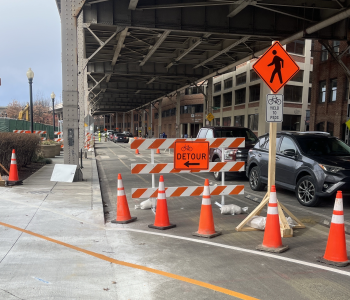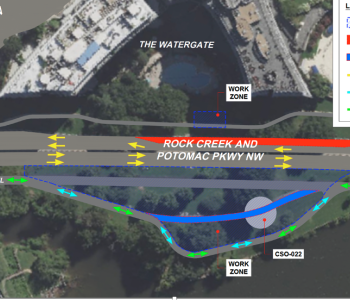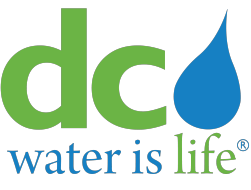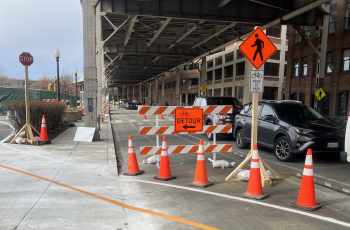What does the ring on the hydrant mean?
Hydrant Tagging for Communication
Horizontal bands are a new enhancement. A hydrant with a colored horizontal band or tape indicates it is an upgraded hydrant that meets the national standard for 4.5 inch nozzles. This standard enables engine companies from Virginia and Maryland to assist DC Fire and EMS during major emergencies in the District without the need for a special adapter.
White designates the hydrant has the standard nozzle; blue, red, green or orange identifies that the hydrant has the 4.5-inch nozzle and also indicates the flow rate the firefighter should expect from that hydrant.
Status rings are another new communications tool.
A Requires Maintenance ring indicates a fully operational hydrant that is available for use during a fire. Typical reasons why a Requires Maintenance ring is placed on a hydrant include a missing chain, a missing cap, or a leak that needs to be attended to at some point in time, but that does not render the hydrant unusable.
An Out-of-Service ring identifies a particular hydrant as not being available for firefighting. Out-of-service rings are placed on hydrants by both DC WASA and FEMS; even though firefighters are provided regular updates on the condition of hydrants directly, the intent of the ring is to alert the firefighter once they are on the scene of an emergency. This information is an important extra precaution for firefighters who frequently make quick decisions to protect property and lives. The water distribution system is redundant so the firefighters almost always have other hydrants in the area available to them during an emergency and they can quickly eliminate those with out-of-service rings.
Typical reasons why a hydrant may be out-of-service include:
o Obsolete hydrants - If DC WASA cannot repair the hydrant or the hydrant is a model that cannot be retrofitted to the national standard, then the hydrant is placed on the construction schedule for replacement. A hydrant is typically replaced within three weeks.
o Damaged hydrants Fire hydrants can be damaged, for example, when struck by a vehicle, or from improper opening for authorized and unauthorized use. Unauthorized use includes landscaping companies illegally filling tanker trucks or children opening hydrants on hot days.
o Inaccessible hydrants - Hydrants that cannot be accessed by firefighters are typically found at construction sites and roadway repairs where there is fencing or barriers that prevent the firefighter from hooking up to the hydrant (road or sidewalk reconstruction/repairs that interfere with a firefighters ability to operate the hydrants may also result in an out-of-service designation.)
o Water main repairs DC WASA must shut off mains to make repairs, which in turn can eliminate water flow to a hydrant. DC WASA crews will place out-of-service rings on these hydrants until water is restored.
Fire Hydrant Upgrade Program
DC WASA launched an aggressive $26.5 million Fire Hydrant Upgrade Program in 2006 to replace nearly 3,000 public hydrants (approximately 35 percent of the District hydrants) over a five-year period. The plan called for approximately 600 hydrants to be installed each year. In FY 2007, DC WASA exceeded this goal by installing 803 hydrants. In FY 2008, WASA is on pace to install over 1,000 hydrants. As part of this program, DC WASA and FEMS agreed to standardize hydrants and adopt the national standard.
Fire Hydrant Inspection and Maintenance Program
DC WASA and FEMS now share responsibility in this program. FEMS performs condition assessments of all District hydrants twice a year, while DC WASA is responsible for repair, maintenance and/or replacement of hydrants.
Using two-man crews, FEMS completed all the condition assessments in September 2007 and resumed inspections in March, and then again in August, of 2008. By December 2008, FEMS will have inspected more than 9,100 public hydrants at least three times. We are not aware of any other jurisdiction that conducts a complete assessment of its entire inventory twice in a 10-month period.
During these inspections, FEMS can obviously inspect hydrants faster than repairs and replacements can be made by DC WASA. So, there are times during the inspection periods when the numbers of maintenance required and out of service hydrants will be much higher. However, DCWASA and FEMS have agreed upon the process for prioritizing hydrant repairs and replacements so that an adequate number of operable hydrants are available at all times for example, if two adjacent hydrants are designated as out of service, at least one of the hydrants is repaired or replaced immediately.
Using 12-14 crews each day, DC WASA has performed major or minor maintenance on 4,980 hydrants and replaced1,431 hydrants since October 1, 2007. In addition to these steps, in the fall of 2007, DC WASA appointed a liaison to the fire department who responds on-site to all two-(or more) alarm fires, bringing maps and checking out the hydrants both before and after firefighting.
Using State-of-the-Art Technology to Improve Services
Handheld Devices Upload Data in Real Time
Further, FEMS and DC WASA are collaborating to incorporate state-of-the-art technology in firefighting and water supply planning. As they inspect public fire hydrants, FEMS is using handheld GPS units developed by DC WASA to locate hydrants, capture the hydrant data and upload the information to DC WASAs database. This process provides nearly real-time hydrant status. Other jurisdictions are closely monitoring our progress with this new, innovative technology for potential introduction in their operations.






